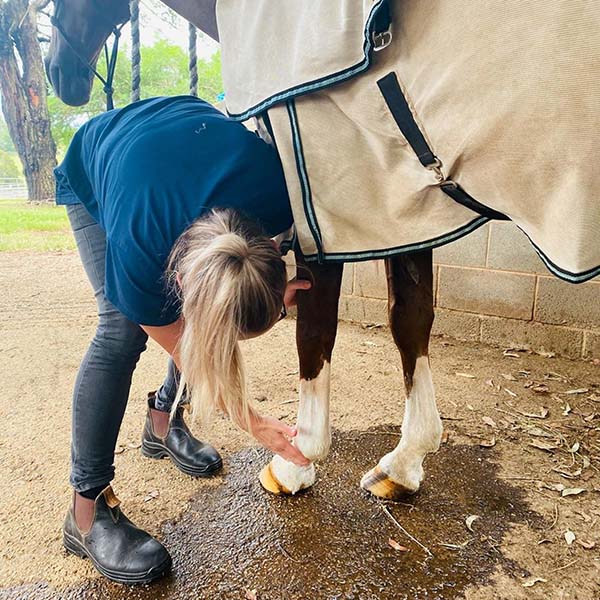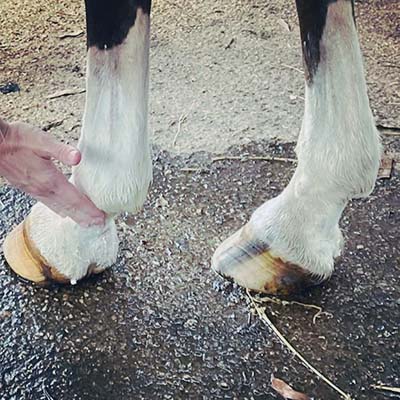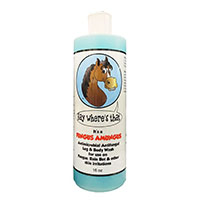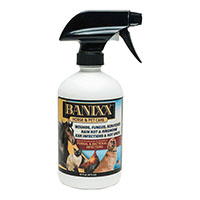
In the muddy spring conditions, many horses are at risk of developing scratches. Also known as mud fever, dew poisoning, greasy heel, cracked heels, pastern dermatitis, or pastern folliculitis, this common skin condition has many names to describe it. Whatever you choose to call it, it all refers to the skin irritation of the back of the pastern (and sometimes other areas), that is frequently seen in wet, muddy conditions, such as spring in New England. We sat down with Katy Raynor, DVM, of New England Equine Medical and Surgical Center in Dover, NH, to learn more about scratches in horses and understand the finer details of treating this recurring skin condition.
What Are Scratches
“Scratches refers to an all too common skin condition in horses that can affect the heel, the back of the pastern, the fetlock, and occasionally up to the level of the cannon bone,” explains Dr. Raynor. In the most simple definition, scratches is a skin irritation of mixed origin, due to moisture creating cracks in the skin, which creates a breeding ground for bacteria, fungus, and/or parasites.“This mixed bacterial, often fungal, and sometimes parasitic skin condition is difficult to treat. The bacteria and fungi find their way into breaks in the horse’s skin and get into the subcutaneous layer (under the skin).”

To the naked eye, scratches look like scabby areas in the affected areas, however additional skin irritation lies under these scabs. In fact, the oozing of the small, infected cuts on your horse’s lower legs causes this scabbing and ulceration. Although the scabs are typically easy to peel off, this is discouraged because this can cause pain and discomfort to the horse and continued peeling of the scabs causes swelling/thickening in the area affected. Dr. Raynor tells us that removing the scabs “compromises the protective barrier of the skin and allows all sorts of other infections to occur, especially in the immunocompromised patient.” Additional symptoms of scratches include matted hair or hair loss, redness, flaky skin, crusty and oozing bumps, lesions, heat, and swelling in the affected area.
A mild form of scratches can be eliminated in a few days of treatment and causes a small amount of discomfort to your horse. However, a chronic condition of scratches can be extremely painful to your horse, sometimes to the point of causing lameness and swelling in the legs. Once your horse has developed a severe case of scratches, veterinary intervention is imperative.
Many equestrians note that horses with white legs or horses with feathers have a predilection for developing scratches. Dr. Raynor explains, “White, unpigmented legs are more susceptible to sun damage, while longer hair retains moisture.”
Preventing Scratches
The best way to prevent your horse from developing scratches is to closely manage their environment. Horses in muddy paddocks or horses that live in moist areas (dewy morning pastures, for example) are at an increased risk for scratches. To combat this, try putting gravel in highly trafficked areas, near the water tank and gate, for example, to keep the areas as dry as possible. If your horse is susceptible to scratches, you may choose to avoid early morning turnout, to allow the heavy dew or frost on the ground the chance to dissipate.
Repeated wetting and drying of the skin can also make your horse a prime candidate for developing scratches. Make sure that you thoroughly dry your horse’s legs after bathing them, rinsing them, or if they become wet during turnout. Additionally, if you choose to use leg boots or wraps on your horse, be sure to dry their legs completely whenever you remove the leg protection. If your horse has feathers, you may decide to clip them for easier maintenance or treat your horse proactively with a product like Shapley’s Original M-T-G to limit the likelihood of a scratches infection.
When it comes to scratches, early detection is the best shot at quick and effective treatments. Check your horse’s legs daily for early signs of infection, such as scaly skin and irritation at the back of the pastern. If you notice an infection beginning, you will want to begin treatment as quickly as possible.
Treating Scratches
“There are many ways to treat the disease process,” Dr. Raynor tells us. “However, the mainstay of scratches is to manage the environment. Without that, the disease process will have a high likelihood of becoming a chronic issue.” The primary defense to allow healing is a dry, clean environment. Horses should be kept off wet pastures or muddy turnouts and housed in a clean, dry stall.
Once you have mitigated the environmental factors to the best of your ability, it is time to address the skin condition. “The easiest way to combat scratches is to start fighting them when they are mild, before the deeper infection creates a disruption of the subcutaneous layer. Once seeded into the deeper layer, the fight becomes much more difficult and requires systemic medications,” Dr. Raynor explains. “Untreated scratches are unpleasant for horse owners and can create cellulitis/lymphangitis along with lameness and extreme discomfort of the horse.”

To treat scratches, carefully clip the hair away from the infected area (aggressive clipping will subject the skin to further injury). Gently wash the affected areas with an antibacterial shampoo (such as chlorhexidine, betadine, or an antifungal shampoo, like Fungasol Shampoo, Hay Where’s That It’s A Fungus Amungus Wash, or Vetericyn Foaming Spray Shampoo) and let it sit for about 10 minutes before gently rinsing. “While it is important not to get the affected leg wet, this one-time shampoo/scrub treatment is important to initiate the set-up for treatment and can be repeated weekly, but please do not shampoo daily as moisture can also allow bacteria/fungi to overpopulate,” says Dr. Raynor.
Thoroughly dry the area using a clean towel and leave to air dry before applying anything topical. This prevents moisture from building up under the topical solution.” The topical treatment should be managed with the help of your veterinarian based on the degree of irritation and the systemic status of your particular horse,” Dr. Raynor notes. Topical solutions and ointments that your veterinarian will recommend for scratches will typically include antibiotics, antifungals, steroids, or a combination of medications; many of our customers have had success using products like Zephyr’s Garden Anti-Fungal Salve, Banixx Wound & Hoof Care, and EquiFit AgSilver CleanBalm Maximum Strength to effectively eliminate scratches from their horse. It is important to use a dry towel daily on the affected site to wipe off any remaining ointment from the day prior. If you detect heat or swelling in the lower limbs, contact your veterinarian immediately.
Generally, you will want to leave the area open to the air. This is because the aerobic (oxygenated) environment will help to keep the area dry and cool (bacteria and fungus thrive in moist, warm conditions). However, in certain circumstances, you may choose to wrap the area with gauze and a cohesive bandage after you have applied a treatment. The situations where you would want to consider wrapping the leg include if it has large open sores or if you are unable to fix your horse’s environment and will be turning them back out in mud. The wrap can also help to soften the scabs and allow the ointments to penetrate. Remove the wraps whenever possible to allow the scratches the chance to dry out again.
If you have been treating scratches for more than two weeks and not seeing results, you should call your veterinarian. In more serious cases, systemic antibiotics may be prescribed by your veterinarian; in these instances, trying several different ointments may not get you ahead of the disease process. Continue treatment until the scratches are completely resolved, and then continue along with diligent management techniques to ensure that the scratches do not return.
Scratches are a nuisance for many horse owners, but, with quick action and attention, you can control this common skin condition. Utilizing preventative practices along with prompt treatment when needed, you can ensure that your horse is comfortable, sound, and scratches free all year round!
At the Cheshire Horse, we carry everything that you need to mitigate a scratches outbreak on your horse. If you have any questions regarding the antifungal and antibacterial scratches treatments that we carry, we encourage you to reach out to a member of our friendly and knowledgeable sales staff.




Thank you!